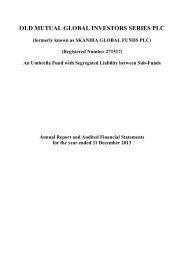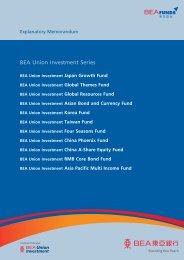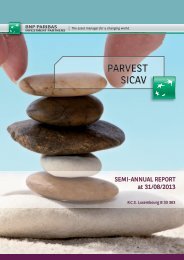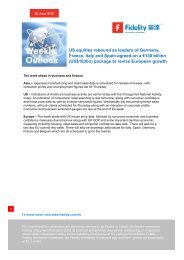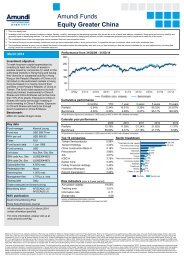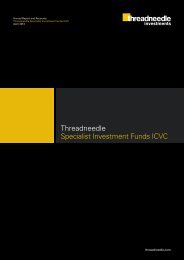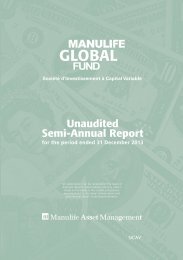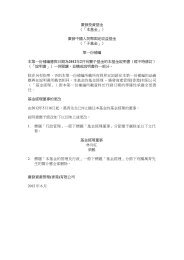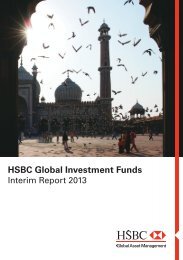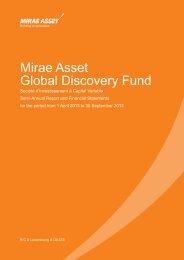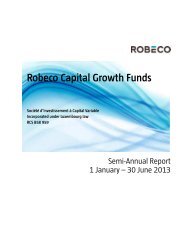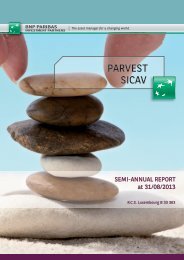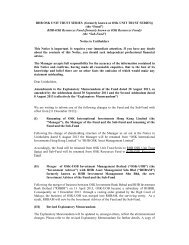JPMorgan Funds Audited Annual Report - JP Morgan Asset ...
JPMorgan Funds Audited Annual Report - JP Morgan Asset ...
JPMorgan Funds Audited Annual Report - JP Morgan Asset ...
You also want an ePaper? Increase the reach of your titles
YUMPU automatically turns print PDFs into web optimized ePapers that Google loves.
<strong><strong>JP</strong><strong>Morgan</strong></strong> <strong>Funds</strong><br />
Notes to the Unaudited Financial Statements (continued)<br />
As at 31 December 2013<br />
The resulting gains and losses on translation are included in “Net Realised Gain/(Loss) on Foreign Exchange” in the Combined Statement of Operations and<br />
Changes in Net <strong>Asset</strong>s.<br />
The reference currency of the Combined Statements is USD.<br />
The principal exchange rates applied as at 31 December 2013 are as follows:<br />
1 USD = 0.72592121 EUR;<br />
1 USD = 0.60437568 GBP;<br />
1 USD = 104.92000000 <strong>JP</strong>Y.<br />
f) Forward Foreign Exchange Contracts<br />
Unrealised gains or losses on outstanding Forward Foreign Exchange Contracts are valued on the basis of currency exchange rates prevailing at the relevant<br />
valuation date. The changes in such amounts are included in “Net Change in Unrealised Gain/(Loss) on Forward Foreign Exchange Contracts” in the<br />
Combined Statement of Operations and Changes in Net <strong>Asset</strong>s. Unrealised gains or losses are recorded under “Unrealised Net Gain/(Loss) on Forward<br />
Foreign Exchange Contracts” in the Combined Statement of Net <strong>Asset</strong>s.<br />
g) Financial Futures Contracts on Securities and Indices<br />
Regulated financial futures contracts are valued at the exchange quoted settlement price. Initial margin deposits are made upon entering into the contracts<br />
and can be either in cash or securities. During the period the contracts are open, changes in the value of the contracts are recognised as unrealised gains and<br />
losses by “marking-to-market” to reflect the market value of the contracts at the end of each business day’s trading. Variation margin payments are made or<br />
received, depending upon whether losses or gains are incurred. The frequency of those margin payments may differ depending on where the contract is<br />
traded. When a contract is closed, the SICAV records a realised gain or loss equal to the difference between the proceeds from, or cost of, the closing<br />
transaction and the initial cost of the contract in “Net Realised Gain/(Loss) on Financial Futures Contracts” in the Combined Statement of Operations and<br />
Changes in Net <strong>Asset</strong>s.<br />
Unrealised gains or losses are recorded under “Unrealised Net Gain/(Loss) on Financial Futures Contracts” in the Combined Statement of Net <strong>Asset</strong>s.<br />
Daily margin calls are recorded under “Net Realised Gain/(Loss) on Financial Futures Contracts” in the Combined Statement of Operations and Changes in<br />
Net <strong>Asset</strong>s.<br />
h) Option Contracts<br />
The SICAV writes options on securities, futures and currencies. These options are settled in cash and subject the SICAV to unlimited risk of loss. The SICAV,<br />
however, is not subject to credit risk on written options as the counterparty has already performed its obligation by paying the premium at the inception of<br />
the contract. As of 31 December 2013, certain Sub-<strong>Funds</strong> had written options contracts outstanding as listed on its Schedule of Investments.<br />
Options purchased are recorded as investments; options written or sold are recorded as liabilities. When the exercise of an option results in a cash<br />
settlement, the difference between the premium and the settlement proceeds is accounted for as a realised gain or loss. When securities are acquired or<br />
delivered upon exercise of an option, the acquisition cost or sale proceeds are adjusted by the amount of the premium. When an option is closed, the<br />
difference between the premium and the cost to close the position is accounted for as a realised gain or loss. When an option expires, the premium is<br />
accounted for as a realised gain for options written or as a realised loss for options purchased.<br />
For options on futures, where the investment manager is based in the United Kingdom, variation margin payments are made or received daily, depending<br />
upon whether losses or gains are incurred on the underlying futures contracts.<br />
i) Total Return Swaps<br />
The SICAV may enter into swap contracts in which the SICAV and the counterparty agree to exchange payments where one or both parties pay the returns<br />
generated by a security, instrument, basket or index thereof. The payments made by the SICAV to the counterparty and vice versa are calculated by<br />
reference to a specific security, on a basket of securities, index, or instruments and an agreed upon notional amount. Any such underlying security or<br />
instrument must be a transferable security and any such index must be an index of a regulated market.<br />
A Total Return Swap will exchange the total performance on a specific basket of securities, selected by the Investment Manager against a reference rate plus<br />
a spread. The total performance will include interests, dividends, gains and losses on the underlying securities during the contract period according to the<br />
type of underlying. The risk of this type of instrument will depend on the uncertain evolution, at the time of the contract conclusion, of the performance of the<br />
underlying. These underlying securities are listed on a primary exchange.<br />
The value of the underlying securities shall be taken into account for the calculation of the investment and borrowing powers applicable to individual issuers. The<br />
relevant indices include, but are not limited to, currencies, interest rates, prices and total return on interest rates indices, fixed income indices and stock indices.<br />
The market values are recorded under “Derivatives Instruments at Market Value” in the Combined Statement of Net <strong>Asset</strong>s. The changes in such amounts are<br />
included in the Combined Statement of Operations and Changes in Net <strong>Asset</strong>s under “Net Change in Unrealised Gain/(Loss) on Derivatives Instruments”.<br />
When a contract is closed, the Realised Gain/(Loss) is recorded under “Net Realised Gain/(Loss) on Derivatives Instruments” in the Combined Statement of<br />
Operations and Changes in Net <strong>Asset</strong>s.<br />
j) Interest Rate Swaps<br />
An interest rate swap is a bilateral agreement in which each of the parties agree to exchange a series of interest payments for another series of interest<br />
payments (usually fixed/floating) based on a notional amount that serves as a computation basis and that is usually not exchanged.<br />
The market values are recorded under “Derivatives Instruments at Market Value” in the Combined Statement of Net <strong>Asset</strong>s. The interests on interest rate<br />
swaps are recorded under “Net Interest on Swap Transactions” in the Combined Statement of Operations and Changes in Net <strong>Asset</strong>s. The changes in<br />
unrealised gains or losses are included in the Combined Statement of Operations and Changes in Net <strong>Asset</strong>s under “Net Change in Unrealised Gain/(Loss) on<br />
Derivatives Instruments”. When a contract is closed, the realised gains or losses are recorded under “Net Realised Gain/(Loss) on Derivatives Instruments” in<br />
the Combined Statement of Operations and Changes in Net <strong>Asset</strong>s.<br />
k) Credit Default Swaps<br />
A Credit Default Swap is a credit derivative transaction in which two parties enter into an agreement, whereby one party pays the other a fixed periodic<br />
coupon for the specified life of the agreement. The other party makes no payments unless a credit event, relating to a predetermined reference asset,<br />
occurs. If such an event occurs, the party will then make a payment to the first party, and the swap will terminate. The value of the underlying securities shall<br />
be taken into account for the calculation of the investment and borrowing powers applicable to individual issuers.<br />
The market values are recorded under “Derivatives Instruments at Market Value” in the Combined Statement of Net <strong>Asset</strong>s. The changes in unrealised gains<br />
or losses are included in the Combined Statement of Operations and Changes in Net <strong>Asset</strong>s under “Net Change in Unrealised Gain/(Loss) on Derivatives<br />
Instruments”. When a contract is closed, the realised gains or losses are recorded under “Net Realised Gain/(Loss) on Derivatives Instruments” in the<br />
Combined Statement of Operations and Changes in Net <strong>Asset</strong>s.<br />
l) To Be Announced Securities (“TBA”)<br />
TBAs are related to mortgage backed securities issued by government sponsored agencies. These agencies usually pool mortgage loans and sell interests in<br />
the pools created. TBAs relate to future pools of these agencies that are bought and sold for future settlement for which either the interest rate or the<br />
maturity date is not yet fixed. TBAs are separately disclosed in the Schedule of Investments.<br />
40



